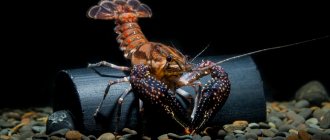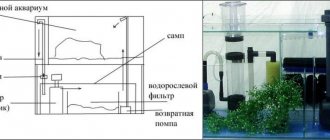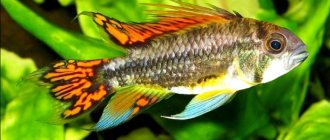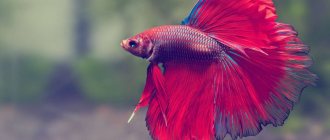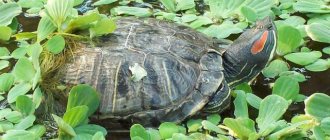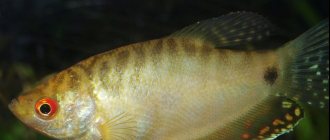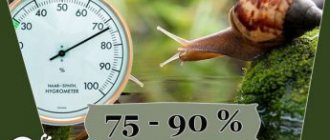Among the variety of aquarium fish, the multi-colored apistogram stands out.
Few people can believe that this fish is a close relative of the familiar perch and is in the same suborder.
Aquarists classify the tropical inhabitant as a species of cichlid, from which recommendations are given on proper maintenance.
General information
Apistogramma is the common name of a genus that includes 100 species. Small fish have a laterally flattened body of short length - from 2 to 8 cm.
The coloring is very bright, in most species combining several contrasting colors.
Particularly rainbow colors are observed in mature males, while fry or females look more modest.
Interesting! The word “apistogram” is translated from Latin as “a stripe curved on the side,” since such decoration is characteristic of most species. Such a line for the fish themselves is not an accessory, but an entire organ for capturing the direction of water movement.
Keeping beautiful apistograms in an aquarium cannot be called simple.
Before purchasing, it is better to gain experience with less fastidious fish or strictly follow the recommended rules for keeping apistograms.
View this post on Instagram
Publication from Muntyan Elena (@muntyan_elena) December 19, 2021 at 9:07 PST
Description
Typically an oval body shape that is laterally compressed; the dorsal and anal fins are elongated, with long pectoral fins.
Apistogramma Borellii are a polychrome species. That is, they occur in a variety of colors, and in many cases one population will have several different variations. There are many color forms in the wild, some of which are particularly colorful.
Some individual males with bright red streaks on their heads look truly spectacular. These color variations are sometimes given commercial names, including the common Apistogramma and the specific Opal or Yellowhead.
Size
Standard length for males: 6.5 cm and females: 5 cm.
Appearance
All types of apistograms have common external characteristics.
- The aquarium fish has a transversely flattened and slightly elongated body. The head is pointed, the eyes are large.
- Sizes, depending on the species, vary in the range of 3–12 cm. Males are brighter and larger than their female relatives.
- The fin on the back is large and consists of 15–20 pointed rays. The pectoral fins are small, round in shape, the anal fin is elongated and formed by 3–6 rays.
- The scales are well defined. The degree of expression of the lateral stripe depends on the species: from wide over the entire length of the body to barely noticeable only near the gills.
- Life expectancy in good conditions is up to 5 years.
- The color can combine almost any color of the rainbow: yellow, red, blue, green. Some hybrid species have neon colors. Most often, the fins are colored in contrast to the body.
Interesting! The brightness of the color depends not only on gender and health, but even on mood. During the mating season it is most pronounced, and, for example, during transplantation it turns pale.
Reproduction
Male apistograms can be distinguished from females by their brighter coloring and larger size.
Reproduction should occur in a spawning aquarium with stable water parameters. The pair spawn on a large stone or wide leaf of a plant. Both parents guard the eggs. When the fry appear, parents often divide them into two groups and each take care of their own, or the two of them take care of all the offspring. Apistograms are gentle and attentive parents. They can stay close to their children for a long time (up to a month), controlling and protecting them. Fry should be fed with live microfeeds: Artemia nauplii, ciliates.
Apistogramma of Pandurini
Natural habitat
In nature, you can find apistograms in the rivers of South America. The reservoir should have a low current speed, a bottom covered with sand and an abundance of algae .
The fish spend most of their time near the shore, where there is shallow depth and it is easy to protect themselves from enemies.
A small family of fish occupies its own territory and carefully guards it from uninvited guests.
The owners may even show aggression when encroaching on their piece of the coastal zone, quickly attacking the fish that swim there.
The same behavior persists in aquarium conditions, especially with a small volume of water.
The fish are thermophilic and can easily tolerate water temperatures of 30 °C almost all year round. In the natural environment, Apistogramma feed on small insects, plankton and detritus.
Spreading
The natural habitat of Apistogramma borellii is the Paraguay and Mato Grosso rivers in the Brazilian state of the same name. In addition, you can find the fish in Bolivia and the northern part of Argentina, as well as in Venezuela
The natural conditions of apistograms are shallow bodies of water with moderate currents or standing water. Often these are just large puddles that form during river floods and, thanks to the humid climate and high level of groundwater, retain their size and do not dry out.
They are usually heavily overgrown, with an abundance of snags and plant roots, as well as a large amount of fallen leaf matter. The processes of decay in clean water give unique parameters - a high level of tannins, a low content of harmful microorganisms, as well as high acidity and a yellowish color, for which the water is nicknamed “brown”.
The fish was first described in 1906 and assigned the species name Apistogramma borellii Regan.
Kinds
The main types (description and photo below) of apistograms differ in color and size.
Interesting! A popular fish called Bolivian apistogramma is no longer classified in this genus, although the Bolivian butterfly (altispinosa) is kept in the same conditions as other species.
Apistogramma ramiresi electric blue
The electric blue apistogram was artificially bred by breeders. The color is bright blue with neon reflections.
Only the upper part of the head is contrastingly colored in a brownish-greenish color scheme, and the iris of the eyes is red.
The maximum length of an adult fish is 6 cm, and to keep a small family you need an aquarium of at least 40 liters.
Apistogramma ramiresi veil
This name is given to the species for its translucent and large fins. At the same time, they are very delicate, they can easily be injured by sharp decorative objects, and other inhabitants of the aquarium can eat them.
The coloring is rainbow with stripes of orange, yellow and green tones. Small blue spots are scattered across the entire surface.
Apistogramma ramirezi balloon
The shape of a small fish is more like a flattened ball about 6 cm in size. The color is orange, and the lateral line is expressed only on the head from the eyes to the mouth.
Golden ramirezi apistogram
The fish is a bright lemon color with blue specks all over its body and translucent fins.
Albino
The bright color of an albino is present only on the head and near the gills. The rest of the fish is gray-white, and the fins are almost transparent.
Cockatoo
Apistogramma cockatoos have well-defined sexual differences. Males reach a size of 8 cm, and their color combines a gray-yellow belly and fiery orange-red fins with black speckles.
The elongated outer rays of the caudal and dorsal fins resemble the crest of cockatoo parrots.
Panda
The species is rarely found in pet stores. The main color of the fish is yellow-green, and the edge of the caudal fin is bordered by an orange rim.
The difference between the female is large black spots near the eyes, gills and at the base of the tail.
Agassiza
A large fish up to 8 cm in length, colored green, brown or blue.
The tail resembles the tip of a spear due to the highly elongated central rays. The black side stripe runs along the entire body.
Banshee
The color can be gray-blue or greenish-yellow with a blue sheen along the edges of the scales.
Hongslo
A motley red-yellow fish with brightly colored and long fins.
Borelli
The coloration among representatives of this species varies depending on the natural habitat.
The predominant colors are yellow with spots of blue or turquoise.
Apistogramma Borelli males are polygamous and need a large territory, so they are kept in an aquarium of at least 50 liters.
Hoigne
The male Apistogramma Hoigne is yellow in color, and during spawning, red stripes appear on the fins.
Females are dark gray with brown speckles and translucent fins.
Eremnopige
A rare type of apistogram, found mainly among collectors of exotic fish.
Norberti
The front of the fish is yellow, while the back is predominantly blue.
The rays of the dorsal fin near the head are red, and dark streaks are scattered near it. A diagonal black stripe runs through the eye.
Kellery
A silver-yellow fish with long fins and a dark stripe on its head. Before the mating season, males develop red speckles on their backs.
Two-lane
A gray-blue fish with a black stripe along the entire body and a red dorsal fin. The female is gray with small yellow spots.
Three stripe
The main color of the fish is greenish-silver. The stripe on the side is clear, and 2 less bright ones run along the back and belly.
Interesting! Females turn yellow during the spawning period.
Panduro
This type of apistogram is very demanding in terms of conditions of detention. Only one pair of fish requires an aquarium with a volume of 100 liters.
The inhabitants themselves do not exceed 8 cm in length, and females can only grow up to 5 cm.
Apistogramma Wilhelmy has similar territorial needs.
The main color of the body and fins of apistogram pandurini is grayish, and it can be diluted by yellow and black spots on the head and an orange stripe on the tail of the male.
Steindachner
Each scale of the Steindachner Apistogramma is edged with black, and the tail has one large spot. The upper half of the body is colored yellow, the lower half blue.
McMaster
A distinctive feature of the McMaster apistogram is its yellow-blue color and 2 black stripes on the sides.
Red spots are present on the fins, and during spawning they turn black on the chest.
Widget
Unlike its fellows, it lives in its natural environment in Australia. The rays of the dorsal fin can even be longer than the entire body and end behind the tail.
The body color is silver-blue; there may be bright orange spots on the upper half of the body and on the fins.
Care requirements and contents of apistograms
Unlike other cyclids, the Apistogramma keeps the aquarium in order. The fish of the group do not gnaw algae and do not dig the soil. An exception is the cockatoo apistogram . It makes holes in the sand, so the fish needs soft soil.
In the photo there is an apistogram electric blue neon
Aquariums with apistogram can be richly decorated with driftwood, plants, and ceramics. Pisces are comfortable in such an environment. By the way, it’s worth building a filter into it. Appistogram loves clean water.
An imitation of flow-through is done by adding approximately 20% fresh water daily. Its temperature should be about 25 degrees. The acid-base balance is also important. If it exceeds 7.5 units, the fish will be uncomfortable and the death of pets is possible.
The apistogram is also sensitive to the volume of water. A couple of fish need at least 25 liters. There are species that require all 60. We will talk about exceptions to the rules in a separate chapter. For now, let’s discuss the parameters of aquariums.
The minimum height of the container for a pair of fish is 30 centimeters. For some apistograms, again, aquariums from 50 centimeters in height are needed. But the lighting is the same for all representatives of the group.
The waters of tropical rivers are shaded by tree crowns, internal vegetation, and snags. Therefore, at home, the apistogram is content with dim light.
Content
A wide variety of types of apistograms require similar conditions for maintenance. It is better to choose a spacious aquarium, with a volume of about 20–30 liters per pair of fish .
The lid is installed for lighting and can be opened slightly, since the apistograms will not jump out of the water.
The main requirements when caring for fish are for water quality:
- Apistograms prefer slightly acidic water with a pH ranging from 6 to 7.5.
- Hardness should be kept below 15.
- The temperature is set at 25...27 °C. From lighting it can rise another couple of degrees, which is easily tolerated by apistograms.
- The water should be renewed weekly by a quarter of its volume.
- Fish are not accustomed to bright light, so you need to install low power lamps or have plants floating on the surface.
- Large-leaved algae are planted on the bottom, driftwood or other accessories are installed where the fish will hide.
View this post on Instagram
Publication from Azizova Lyubov (@ljubov_azizova) Oct 19, 2021 at 10:46 PDT
Feeding
The fish are fed dry food with a balanced composition . The best mixtures for tropical fish or bright colors are Tetra Ruby or Tetra PRO Color.
When kept together with other fish, it is better to add special granules for cichlids , which smoothly sink to the bottom.
If active neighbors collect the main portion of food faster, then the apistogramma will be able to eat more from the bottom.
Feed is given twice a day. Apistograms do not limit themselves when eating, therefore, to maintain their health, a portion of fish should be completely eaten within 3–5 minutes .
It is better not to use live food, even frozen , since it can introduce infectious agents and helminths into the water.
To pamper your fish, you can give them professional supplements made from invertebrates and plankton in the form of jelly once a week.
How do they eat?
In the photo you can often see how a flock of ramirezi takes food: quickly, actively, greedily. They will eat as much as they give. But this is an undesirable fact. When they overeat, they have digestive problems, causing the little inhabitants of the aquarium to get sick. The daily diet should be divided into two times and food should be given in small portions.
The fish is omnivorous. I will be glad:
- chopped vegetable food;
- minced seafood;
- frozen food from microorganisms;
- bloodworms and tubifex.
From time to time you can also turn to plate feed, rich in vitamins and microelements. Coloring and activity in behavior will only benefit from this.
With good nutrition they grow quite quickly. Thus, an Agassian apistogram can increase in size several times in six months.
Compatibility
It is not necessary to keep only apistograms - they easily get along with other peace-loving fish .
Important! It is better to choose neighbors for apistograms of the same size or slightly smaller. Fish can constantly hide from large species and not reproduce.
Suitable for living together in an aquarium are guppies, neons, swordtails, mollies , small barbs, and rhodostomuses .
It is necessary to take into account not only the nature, but also the preferred water temperature for different types of fish.
For example, in neons, at high thermometer readings, metabolic processes proceed faster, and their life expectancy can be sharply reduced.
Shrimp will not be able to offend adult apistograms. If their reproduction is planned, then most likely the swimming fry and eggs will become live food for crustaceans.
View this post on Instagram
Posted by Ilya (@shims_aqua) March 21, 2021 at 7:11 PDT
Feeding
Apistogramma are predators; in nature they feed on insect larvae, fry, and invertebrates. In the aquarium, all types of Ramirez's Apistogramma are fed with any live food; the fish prefer rotifers, daphnia, cyclops, and bloodworms. Consumed in ice cream, flakes and dry food.
Return to content
Ramirezi blue neon
Breeding
Apistogramma breed in a calm environment in a common aquarium, but can be placed in a separate container.
The spawning of the resulting pair is stimulated by an increase in water temperature and a decrease in hardness.
It is important to consider that intersexual relationships differ depending on the species . Some mate for life, while others need several females.
During spawning, Apistogramma become more active and defend their territory from relatives and other inhabitants of the aquarium.
The female lays 100–200 eggs in shelters near the bottom , under snags or grottoes.
The expectant mother continues to care for her offspring; there is no need to separate her separately. The male plays the role of a protector and tries to keep strangers away from the eggs.
In the eggs, the embryos mature for several days, after which the larvae hatch. They remain motionless on the substrate for several more days and feed from the yolk sac.
The young begin to swim and look for food 5–7 days after laying eggs . Coloring in fry appears only at 3 months.
Interesting! The sex of future fish depends on the water temperature: more males will hatch when the thermometer is about 30 °C.
Diseases and prevention
Apistogramma immunity is reduced by stress, poor quality water and constant overeating. Fish can become infected with viruses, bacteria or parasites.
- It is impossible to cure fish from viruses , so quarantine should not be neglected when purchasing new aquarium inhabitants.
- The scales of apistograms are often parasitized by ichthyophthyriosis . It is treated with an antibacterial drug added to the general aquarium.
- pathogenic bacteria appear in the water . Infected apistogramma look lethargic, there is no appetite, and the fish even die. It is difficult to find an effective drug for treatment, so it is better to monitor the quality of the water.
It is a pleasure to watch bright apistogrammas, but a capricious aquarium fish cannot exist in inappropriate conditions and without proper care.

